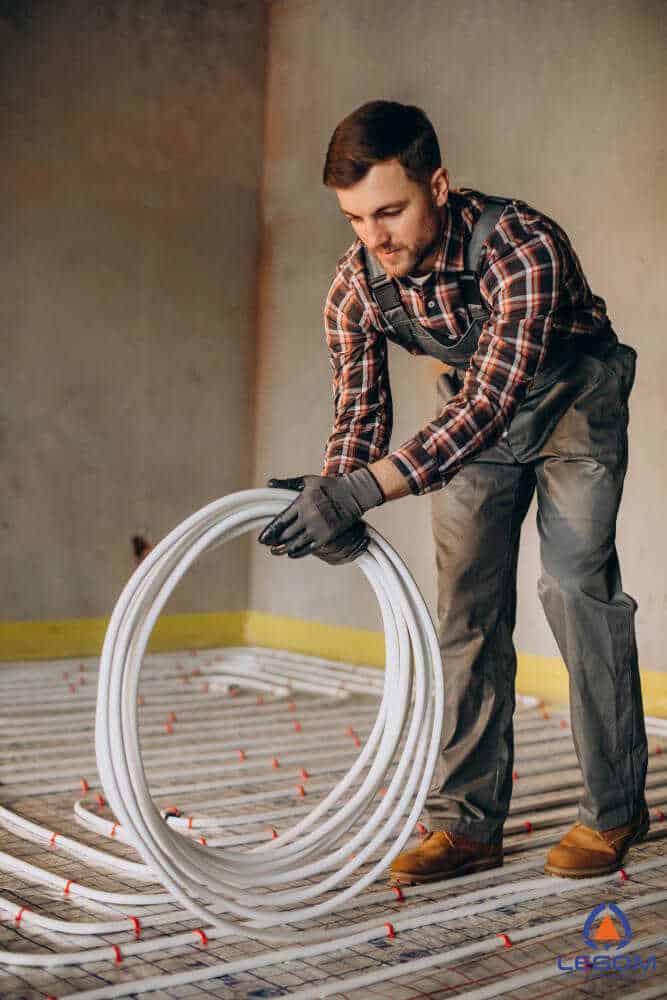
Underfloor heating installation refers to the process of setting up a heating system beneath the floor surface of a building. This heating system is designed to provide warmth by radiating heat from the floor upwards. Its function is to create a comfortable and even temperature throughout the room. Underfloor heating can be used in both residential and commercial buildings.
Contents
Types of Underfloor Heating Installation Systems
There are two main types of underfloor heating systems, namely hydronic (water-based) and electric. The following is a more detailed explanation of both.
Hydronic (Water Based) Underfloor Heating

Hydronic or wet underfloor heating is known for its efficiency and ability to maintain a consistent, comfortable temperature. This system involves circulating warm water through a network of pipes or hoses installed below the floor surface. Water is heated by a boiler or other heat source before being pumped through pipes. Hydronic underfloor heating offers energy efficiency and the ability to maintain a consistent, comfortable temperature throughout a room.
Electric Underfloor Heating
This system uses electrical cables or heating mats that are installed below the floor surface. When electric current passes through these elements, they generate heat, which is then radiated upwards.
Electric underfloor heating systems are often easier and cheaper to install compared to hydronic systems. Especially in existing buildings.
Benefits of Underfloor Heating Installation
The benefits of underfloor heating include the following things.
- Even Heat Distribution: Underfloor heating provides more even heat distribution compared to radiators or traditional forced-air systems.
- Energy Efficiency: A well-designed underfloor heating system can be energy efficient. The reason is because it can operate at lower temperatures compared to traditional heating systems.
- Space Saving: underfloor heating can free up space for other purposes because there are no radiators taking up wall space,
- Comfort: Many consider radiant heat from the floor to be more comfortable than convection heat from radiators.
- No Door Heater: There are no conspicuous heaters or radiators. This enhances the interior design and room arrangement flexibility.
How to Install Underfloor Heating Installation
Installing underfloor heating involves several important steps, depending on the type of system chosen. Is it hydronic (water based) or electric. What is clear, the installation process involves placing heating elements under the floor. Below is a general installation guide for each type.
Hydronic (Water Based) Underfloor Heating
Preparation
Identify the area where underfloor heating will be installed. Then make sure the ground floor or substrate is in good condition.
Pipe Installation
Place water-filled pipes or hoses in the cavities beneath the floor. Use a screed system over the pipes to level the floor surface and distribute heat.
Connection to a Heat Source
Connect the pipe to a heat source, such as a boiler or water heater. Make sure this system is connected to a temperature control to regulate the heat produced.
Testing
Test the system to ensure there are no leaks in the pipes. Verify that the system can reach and maintain the desired temperature.
Electric Underfloor Heating
Preparation
Clean and prepare the floor surface. Make sure the floor is level and free from sharp objects.
Cable/Electrical Installation
Place electrical cables or mats evenly under the floor. Follow the manufacturer’s installation instructions for proper spacing and installation pattern.
Connect to a Power Source
Connect the cable or mat to a suitable power source. Use a thermostat to control the temperature and turn off the system when not needed.
Testing
Test the system to ensure that the heater functions as expected. Check the temperature and heat distribution throughout the area.
Important Tips for Underfloor Heating Installation
To understand this part of the discussion, it’s a good idea to look at the following review.
- Underfloor heating is best installed during new construction or major renovations, but it can also be retrofitted in some cases.
- Some types of flooring are more suitable for floor heating systems. For example, ceramic tiles, natural stone, or laminate which are good at conducting heat.
- Floor heaters tend to require little maintenance, but regular maintenance such as cleaning and checking the thermostat is recommended.
- Be sure to follow proper installation guidelines to ensure the system functions effectively and safely.
- If you are unsure or inexperienced, it is best to leave underfloor heating installation to a professional to ensure safety and optimal performance.
- Pay attention to applicable regulations and safety standards.
- To create an efficient and controllable floor heating system, don’t forget to use a number of reliable products from Legom. We released a Wax thermostatic element that helps keep the floor temperature at a comfortable level. There is also a thermal actuator which plays a role in controlling floor heating. To make it easier to control temperature settings, Legom also provides room thermostats, HVAC valves, manifolds, and many other products that can be ordered OEM or ODM.
So, that’s the article about underfloor heating installation types. Hopefully this article can increase our insight into this tool. So that way, we don’t need to hesitate if we want to install this tool wherever we need it.
